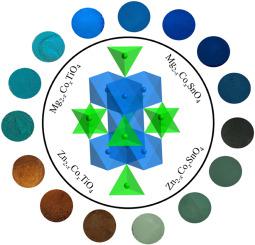当前位置:
X-MOL 学术
›
Prog. Solid State Chem.
›
论文详情
Our official English website, www.x-mol.net, welcomes your feedback! (Note: you will need to create a separate account there.)
Understanding color variation with site distribution in inverse spinel structure via neutron diffraction, magnetism, and optical studies
Progress in Solid State Chemistry ( IF 12.0 ) Pub Date : 2024-04-04 , DOI: 10.1016/j.progsolidstchem.2024.100455 Anjali Verma , Jun Li , Arthur P. Ramirez , M.A. Subramanian
Progress in Solid State Chemistry ( IF 12.0 ) Pub Date : 2024-04-04 , DOI: 10.1016/j.progsolidstchem.2024.100455 Anjali Verma , Jun Li , Arthur P. Ramirez , M.A. Subramanian

|
Chromophores at different coordinations can give rise to different colors; usually, chromophores at non-centrosymmetric coordinations are preferred for intense pigments. Different solid solutions CoO ( = Mg/Zn, and Ti/Sn) with inverse spinel structure were synthesized with the goal of understanding color variation with site distribution, as the chromophore Co in these solid solutions can occupy either the tetrahedral or octahedral sites or both depending on the composition. Another goal was to develop environmentally friendly and cheap blue pigments by reducing the carcinogenic cobalt to obtain a similar color to that of commercially available cobalt blue, which uses a significant amount of Co (33.31 % by mass). For MgCoTiO series, turquoise blue hues were observed for low cobalt content, and different shades of blue were observed for MgCoSnO series with a color similar to cobalt blue, including just 4.90% of cobalt by mass. While for ZnCoTiO, and ZnCoSnO series, different shades of brown and different shades of green, respectively, were observed. One of the main reasons behind the major difference in color for the Mg and Zn containing solid solutions, regardless of the same chromophore in the same structure is related to the chromophore site distribution in the system. For the Mg-containing solid solutions, different shades of blue are observed as Mg has no preference for any of the sites, Co mostly goes to tetrahedral sites. In contrast, for the Zn-containing solid solutions, no blue shades were observed because of the strong preference of Zn for the tetrahedral sites owing to the sp hybridization, which in turn forces Co to occupy the octahedral sites. Neutron refinement proves that Co occupies mainly tetrahedral sites in the Mg-containing solid solutions and mostly octahedral sites in the Zn-containing solid solutions.
中文翻译:

通过中子衍射、磁性和光学研究了解反尖晶石结构中颜色随位点分布的变化
不同配位的发色团可以产生不同的颜色;通常,对于浓色颜料,优选非中心对称配位的发色团。合成了具有反尖晶石结构的不同固溶体 CoO(= Mg/Zn 和 Ti/Sn),目的是了解颜色随位点分布的变化,因为这些固溶体中的发色团 Co 可以占据四面体或八面体位点或同时占据这两种位点取决于成分。另一个目标是通过减少致癌钴来开发环保且廉价的蓝色颜料,以获得与市售钴蓝相似的颜色,而市售钴蓝使用了大量的钴(按质量计33.31%)。对于 MgCoTiO 系列,由于钴含量较低,观察到翠蓝色调;对于 MgCoSnO 系列,观察到不同深浅的蓝色,其颜色类似于钴蓝色,其中钴质量分数仅为 4.90%。而对于 ZnCoTiO 和 ZnCoSnO 系列,分别观察到不同深浅的棕色和不同深浅的绿色。无论同一结构中的相同发色团如何,含镁和锌的固溶体颜色存在重大差异的主要原因之一与系统中发色团位点的分布有关。对于含镁固溶体,观察到不同深浅的蓝色,因为镁对任何位点没有偏好,而钴主要位于四面体位点。相反,对于含锌固溶体,没有观察到蓝色阴影,因为由于 sp 杂化,Zn 对四面体位点有强烈的偏好,这反过来又迫使 Co 占据八面体位点。中子细化证明Co在含Mg固溶体中主要占据四面体位点,在含Zn固溶体中主要占据八面体位点。
更新日期:2024-04-04
中文翻译:

通过中子衍射、磁性和光学研究了解反尖晶石结构中颜色随位点分布的变化
不同配位的发色团可以产生不同的颜色;通常,对于浓色颜料,优选非中心对称配位的发色团。合成了具有反尖晶石结构的不同固溶体 CoO(= Mg/Zn 和 Ti/Sn),目的是了解颜色随位点分布的变化,因为这些固溶体中的发色团 Co 可以占据四面体或八面体位点或同时占据这两种位点取决于成分。另一个目标是通过减少致癌钴来开发环保且廉价的蓝色颜料,以获得与市售钴蓝相似的颜色,而市售钴蓝使用了大量的钴(按质量计33.31%)。对于 MgCoTiO 系列,由于钴含量较低,观察到翠蓝色调;对于 MgCoSnO 系列,观察到不同深浅的蓝色,其颜色类似于钴蓝色,其中钴质量分数仅为 4.90%。而对于 ZnCoTiO 和 ZnCoSnO 系列,分别观察到不同深浅的棕色和不同深浅的绿色。无论同一结构中的相同发色团如何,含镁和锌的固溶体颜色存在重大差异的主要原因之一与系统中发色团位点的分布有关。对于含镁固溶体,观察到不同深浅的蓝色,因为镁对任何位点没有偏好,而钴主要位于四面体位点。相反,对于含锌固溶体,没有观察到蓝色阴影,因为由于 sp 杂化,Zn 对四面体位点有强烈的偏好,这反过来又迫使 Co 占据八面体位点。中子细化证明Co在含Mg固溶体中主要占据四面体位点,在含Zn固溶体中主要占据八面体位点。



























 京公网安备 11010802027423号
京公网安备 11010802027423号